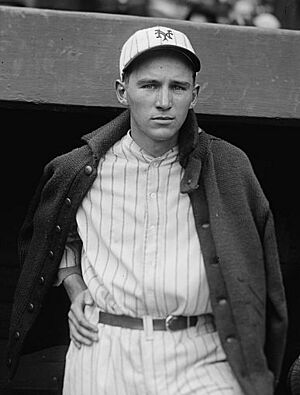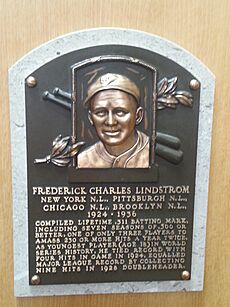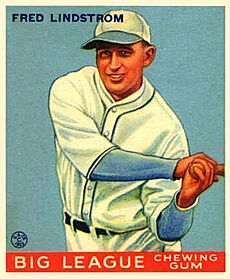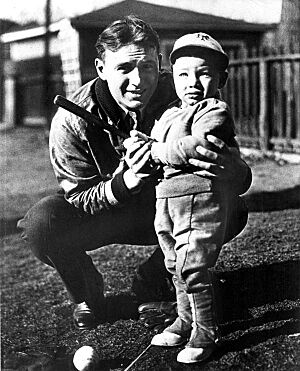Freddie Lindstrom facts for kids
Quick facts for kids Freddie Lindstrom |
|||
|---|---|---|---|
 |
|||
| Third baseman / Outfielder | |||
| Born: November 21, 1905 Chicago, Illinois, U.S. |
|||
| Died: October 4, 1981 (aged 75) Chicago, Illinois, U.S. |
|||
|
|||
| debut | |||
| April 15, 1924, for the New York Giants | |||
| Last appearance | |||
| May 15, 1936, for the Brooklyn Dodgers | |||
| MLB statistics | |||
| Batting average | .311 | ||
| Home runs | 103 | ||
| Runs batted in | 779 | ||
| Teams | |||
|
|||
| Induction | 1976 | ||
| Election Method | Veterans Committee | ||
Frederick Charles Lindstrom (born November 21, 1905 – died October 4, 1981) was an American professional baseball player. He mostly played as a third baseman and outfielder. He played in Major League Baseball (MLB) for the New York Giants, Pittsburgh Pirates, Chicago Cubs, and Brooklyn Dodgers. His career lasted from 1924 until 1936. Freddie Lindstrom was honored by being inducted into the Baseball Hall of Fame in 1976.
Lindstrom started his MLB career with the New York Giants in 1924. In 1930, the Giants' manager, John McGraw, thought Lindstrom was one of the top 20 players of the past 25 years. Even famous player Babe Ruth chose him as his favorite third baseman for the National League in the years leading up to the first All-Star game in 1933. Some baseball experts today, like Bill James, also rate Lindstrom highly among third basemen. They even called the Giants' infield in 1927, which included Lindstrom, the best of that decade.
In 1931, Lindstrom had some injuries, including a long-term back problem and a broken leg. These injuries led him to switch from playing third base to playing in the outfield. The Giants traded him to the Pirates before the 1933 season. He also played for the Cubs and Dodgers before he stopped playing baseball in 1936, after 13 seasons.
Contents
Early Life and Baseball Beginnings
Lindstrom was born on November 21, 1905, in Chicago, Illinois. His home was close to Comiskey Park, a famous baseball stadium. As a young boy, Lindstrom was a big fan of the Chicago White Sox. He often missed school to go watch their games. He was very sad when his favorite player, Shoeless Joe Jackson, and other teammates were banned from baseball. This happened because they were accused of cheating in the 1919 World Series.
Lindstrom went to Loyola Academy in Wilmette, Illinois. When he was in his second year of high school in 1922, he tried out for the Chicago Cubs. However, he ended up signing a contract with the New York Giants. The Giants sent him to play for a minor league team called the Toledo Mud Hens. He played for Toledo for two years. During this time, he played alongside future Giants teammates like Travis Jackson and Bill Terry.
Playing for the New York Giants
The Giants brought Lindstrom up to the major leagues for the 1924 season. Lindstrom was only 18 years old. In the 1924 World Series, he hit for a very good .333 batting average. In one game, he got four hits against the famous pitcher Walter Johnson. He also played perfectly in the field, making no errors. Walter Johnson himself said Lindstrom was "a wonder" and "the brightest star" in the series.
Lindstrom was the youngest player ever to play in a World Series game. In the final game of the series, a tricky bounce over his head in the 12th inning led to the winning run for the other team. Some people unfairly blamed Lindstrom for this play, calling it an "error." However, it was not officially an error, and his manager said it wasn't Lindstrom's fault. He said it could have happened to anyone.
Back then, fielders' gloves were very simple, with little padding. Despite this, Lindstrom was one of the best third basemen in the National League for three of the next four seasons. He led the league in fielding percentage, which measures how well a player fields the ball. In 1928, he also led the league in assists. He had 231 hits in both 1928 and 1930. In one doubleheader, he got nine hits, a record that still stands today! By the time Lindstrom was 25, he had already gotten 1,186 hits. This was one of the highest totals for any player his age in MLB history.
A writer named Arnold Hano called the Giants' infield of the late 1920s "a million-dollar infield." Fans would come early just to watch them practice their amazing fielding skills. Hano even said that a catch Lindstrom made in 1932 was even more amazing than Willie Mays' famous catch in 1954. Lindstrom made a full-length, leaping catch before crashing into the outfield wall. The New York Herald Tribune newspaper called it "the greatest catch ever made in the Polo Grounds," which was the Giants' home stadium.
During his nine seasons with the Giants, Lindstrom had a .318 batting average. He was known for getting important hits when his team needed them most. For example, in September 1928, his batting average went from .342 to .358 because of a hitting streak. In 1930, it went from .354 to .379. Even in 1935, when he played for the Chicago Cubs, his amazing .427 batting average during a 21-game winning streak helped the Cubs win their league championship.
Lindstrom was often called "the last of the great place hitters" on manager McGraw's teams. These teams focused on getting runners into scoring position rather than hitting home runs. In 1931, Lindstrom thought he would become the Giants' new manager. However, the team owner chose Bill Terry instead. Lindstrom was upset and asked to be traded. He later said this was "the worst mistake I ever made."
Playing for the Pirates, Cubs, and Dodgers
After being traded, Lindstrom joined the Pittsburgh Pirates in 1933. He played in the outfield between two famous brothers, Lloyd and Paul Waner. He finished the season with a .310 batting average, which was the eighth highest in the National League. He also led all center fielders in the league with a .986 fielding average.
In 1934, the Pirates' manager was fired. The new manager, Pie Traynor, moved Lindstrom to left field. Later, Lindstrom broke his finger during practice and had to sit on the bench. Even though he played fewer games, he still had a great fielding average of .990. At the end of the season, he was traded to the Chicago Cubs. The Cubs' manager, Charley Grimm, said Lindstrom became "a vital asset" to the team. He helped them win the league championship in 1935. Lindstrom started at third base and then moved to center field. Grimm said that Lindstrom was so good in center field that he only let seven easy fly balls drop during the team's 21-game winning streak. He also helped the Cubs win seven of those games by either scoring the winning run or hitting it in.
After the Cubs lost the 1935 World Series to the Detroit Tigers, Lindstrom was released from the team. He then signed with the Brooklyn Dodgers. However, his time with the Dodgers was short. After only 26 games, he retired from baseball. This happened after he collided with another player, Jimmy Jordan, while trying to catch a pop fly. Lindstrom reportedly said, "I have been in this league 12 years, and it never happened to me until I put on a Brooklyn uniform."
In his 13-year career, Lindstrom played 1,438 games. He had a career batting average of .311, with 1,747 hits. He hit 103 home runs and had 779 runs batted in. He hit over .300 seven times in his career. On May 8, 1930, he even hit for the cycle, which means he got a single, double, triple, and home run all in the same game! In 11 World Series games, he had a .289 batting average.
Life After Baseball
After retiring from playing, Lindstrom managed minor league baseball teams in Arkansas and Tennessee. He then coached the Northwestern University baseball team for 13 seasons. After that, he became the postmaster of Evanston, Illinois, a job he held until 1972.
Freddie Lindstrom passed away on October 4, 1981, in Chicago. He is buried with his wife, Irene, in All Saints Cemetery. His youngest son, Chuck Lindstrom, also played briefly for the Chicago White Sox in 1958.
Freddie Lindstrom's Baseball Legacy

Even though some baseball historians today think Pie Traynor was the best fielding third baseman of that time, Traynor actually led the league in errors many times. Lindstrom had fewer errors in the seasons they both played third base. In fact, for the seven years they both played third base, Lindstrom's fielding percentage was better than Traynor's every single year.
Many baseball experts and sportswriters have praised Lindstrom's skills. Some have even listed him as the best all-time third baseman for the New York Giants. A famous sportswriter named Red Smith put Lindstrom at third base on his all-time New York all-star team. Another writer, John Kieran, reported that pitcher Arthur Nehf said Lindstrom was "the cleverest" hitter on the Giants and "the hardest man to fool in the clutch."
Lindstrom's four hits in Game 5 of the 1924 World Series set a record for rookies. This record was not matched until 2010 by Buster Posey. Lindstrom also had impressive hitting streaks, including a 24-game streak in 1930 and a 25-game streak in 1933. He is also known for having very few strikeouts compared to his high batting average.
In 1932, Lindstrom led the league in outfield assists, which means he threw out many runners from the outfield. In 1933, he led the league in putouts. He was known as a strong defensive player and a great hitter who often hit line drives.
Recent research has shown just how amazing Lindstrom's 1930 season was. He batted an incredible .480 when runners were in scoring position (meaning they were on second or third base). This is the highest batting average with runners in scoring position in Major League history! Overall, he hit .379 that season.
Lindstrom was first considered for the National Baseball Hall of Fame in 1949. However, he didn't get enough votes from baseball writers for many years. Later, some of his former Giants teammates, Bill Terry and Frankie Frisch, joined the Veterans Committee. This committee helps choose players for the Hall of Fame. They helped many of their former teammates get into the Hall, including Lindstrom in 1976.
Some people thought Lindstrom's selection, along with a few others chosen by the Veterans Committee, was not strong enough. They felt the committee was not strict enough in choosing members. However, many famous baseball writers, like Red Smith, supported Lindstrom's induction.
See also
- List of Major League Baseball players to hit for the cycle



